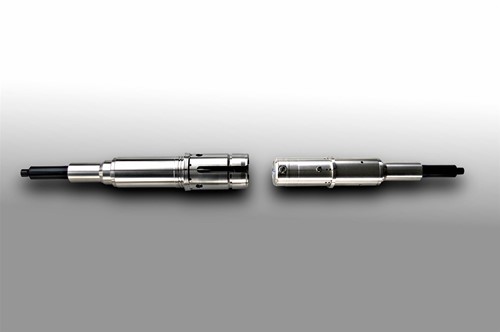ETI and MacArtney announce technology project to significantly reduce subsea cable costs for marine energy devices
The wet-mate connector project could considerably reduce the cost of cabling from offshore wave and tidal farms to the shore by allowing cables to be connected on the seabed and increasing the voltage rating.
A project which could considerably reduce the cost of cabling from offshore wave and tidal farms to the shore has been announced by the Energy Technologies Institute (ETI).
This 18 month project, costing £1.1m and led by MacArtney, will develop an 11kV wet-mate connector, which will be tested and demonstrated under workshop and real-sea conditions.
The connectors enable two power cables to be linked together. Currently, marine device developers either use dry-mate connectors, which have to be lifted out of the water and connected on a barge, or they use a 6.6kV wet-mate connector which is not a high enough voltage rating for efficient transmission of maximum outputs from devices back to shore.
The use of these higher voltage wet-mate connectors in future arrays is expected to lead to considerably lower installation, operating and maintenance costs, and more rapid deployment of marine energy arrays . They will enable the use of remotely operated vehicles to perform electrical connections on the sea-bed instead of having to deploy barges to perform these connections above the surface.
The increase in voltage rating to 11kV could significantly reduce the capital costs associated with offshore energy installations since higher voltage connectors allow more power to be transmitted per cable.
ETI Chief Executive Dr David Clarke said: “Developing wet-mate connectors with a significantly higher kV rating will considerably reduce the cost of tidal and energy arrays by cutting the cable costs to shore and simplifying device installation.
“Although it’s estimated that marine energy could supply up to 2GW of UK electricity demand by 2020 and significantly more than this by 2050, the electricity costs need to be more competitive with established renewable and conventional generation.
“Achieving significant operating cost reduction is critical to the long-term development and success of the marine energy industry in the UK. Projects of this nature will benefit any marine device developer and it has the potential to benefit other offshore energy installations.”
Steen Frejo System Sales Manager for MacArtney said: “This project marks a new and important milestone for the renewable energy market. This development will save time and money for offshore renewable energy projects and bring the industry closer to even more economically viable offshore energy farms.
“MacArtney is proud to be invited by ETI to bring our experience within the renewable energy sector into this exciting project, which we feel has the potential for enormous effect within the industry.”
Amaan Lafayette, Marine Development Manager at E.ON, said: “This project is a good enabling move for the sector and the intended outputs, when achieved, will be of significant benefit.”
The ETI brings together the complementary capabilities of global industrial groups – BP, Caterpillar, EDF Energy, E.ON , Rolls Royce and Shell - in a unique approach with the UK government. Operating at a national strategic level it is delivering large scale complex engineering solutions for the UK energy system helping to meet 2050 challenges.
The ETI is addressing all aspects of the UK energy system – Power, Heat, Transport and the associated infrastructure and its key programme areas are currently Offshore Wind, Marine, Distributed Energy, Buildings, Energy Storage and Distribution, CCS and Transport.




